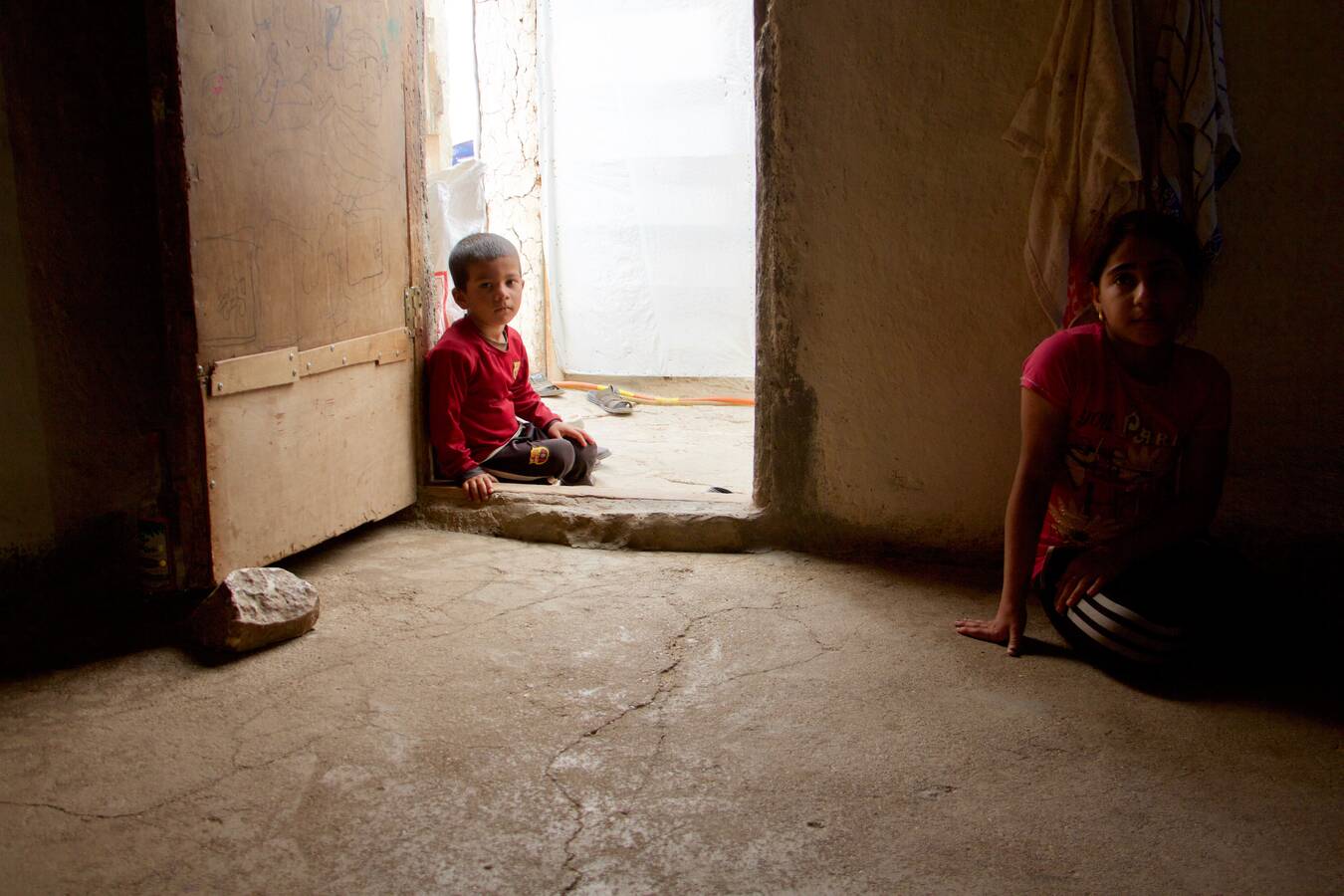Around us the rubble of West Mosul throws a fine white dust into the air. It coats your clothing and grits your hair, covers your shoes and camera lens and gets into just about everything else. I find myself wondering what percentage of my newly acquired Mosul particles are vaporized human remains.
Of course, people were not the only targets in the Old City during ISIS’ last stand before being driven from Mosul in July 2017. Centuries of Christian and Muslim places of worship were reduced to piles of gravel and debris.
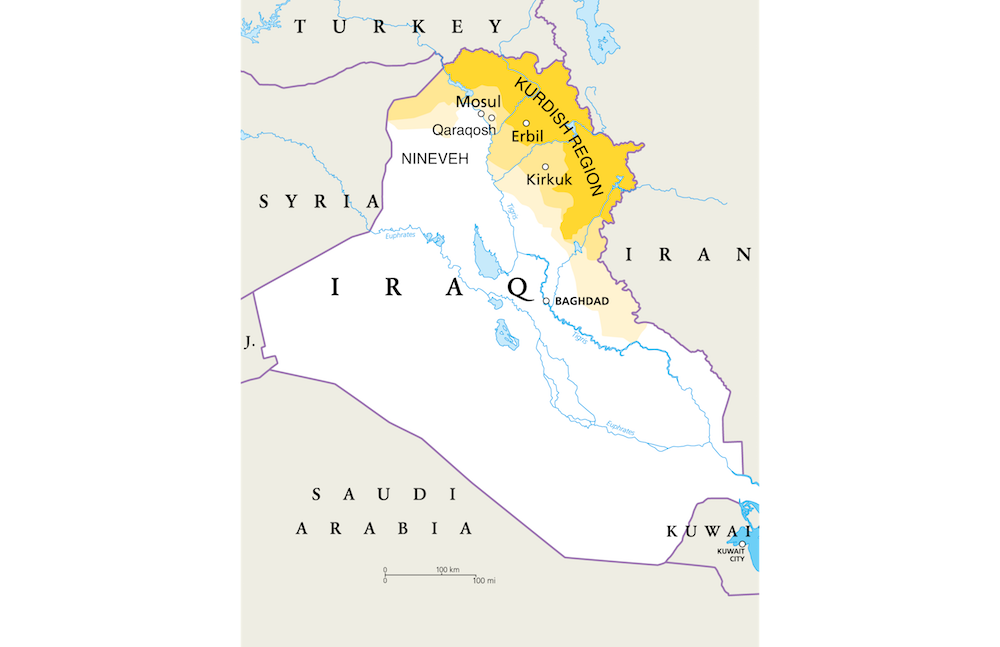
The view from atop a remnant of the collapsed roof of the Syriac Catholic Cathedral of the Immaculate Conception (the Church of Al-tahira), parts of which date back to the seventh century, is especially disheartening. Though the sounds of hammers and circular saws at work in the streets below can be heard this October morning, the perspective is one of utter desolation in all directions. What a spiteful, retreating ISIS, disparagingly referred to here as Daesh, did not destroy, U.S. and Iraqi air and drone strikes pounded into rubble. (Much of the debris from the church sites has since been removed, but little progress otherwise has been made toward the restoration of the Old City’s ruined churches, and the United Nations Mine Action Service estimates it could take decades to completely clear thousands of tons of explosive hazards, from suicide belts to improvised devices, out of Mosul.)
My impromptu guide on this visit, Yohanna Towaya, a Syriac Catholic and a professor at a satellite site of the University of Mosul, has made many trips into the Old City since its liberation. He considers the visits completely safe. “These people are Iraqis; I know them,” Mr. Towaya says. “The trouble came from outside,” he adds, explaining that the most vicious members of ISIS were extremist recruits from other nations, not local Sunni Muslims.
What a spiteful, retreating ISIS, disparagingly referred to here as Daesh, did not destroy, U.S. and Iraqi air and drone strikes pounded into rubble.
Not everyone shares that assessment. The night before my visit, a security analyst in Erbil, across the border in the autonomous region of Iraqi-Kurdistan, provides a one-man seminar on conditions in Mosul, expounding on the many dangers that await me there—ISIS snipers, I.E.D.s and sleeper cells looking for opportunities to kidnap Westerners feature prominently in his enthusiastic presentation. Around the city Shiite militia and Iraqi army checkpoints halt traffic, but inside Mosul’s bombed-out districts security forces of any sort are barely evident.
“Who told you that ISIS is finished in this area?” he asks, grimacing and shaking his head. “ISIS is reorganizing itself,” he says confidently. Its members have shaved their beards and melted back into the populace; they are waiting, he assures me.
“We are still finding bodies and booby traps,” the security analyst says, asking if I will be traveling through Mosul in an armored vehicle.
Sweet Tea in Mosul
Just a few hours later, I am sitting among strangers in a tea shop in the Old City, Sunni Muslims who have returned to the ruins to start over, and I am drinking a small glass of sweet tea with them, no armored vehicles in sight. Along this former commercial corridor, a scattering of shops have reopened—breakouts of bright colors among the gray and black of the blasted storefronts.
The tea shop owner and his patrons seem happy to have an American among them; the few inhabitants of this gray skeleton of a city are keen to show what hospitality they can muster. One customer is a young man from the Red Crescent Society eager to practice his English; Solane Ghazi explains that most of the people at the shop live in the remnants of what had been their homes. Their poverty and the lack of any meaningful assistance from Baghdad leave them no other option.
“This man’s house,” he says, pointing to one of the guests at the tea shop, “was eradicated completely.”
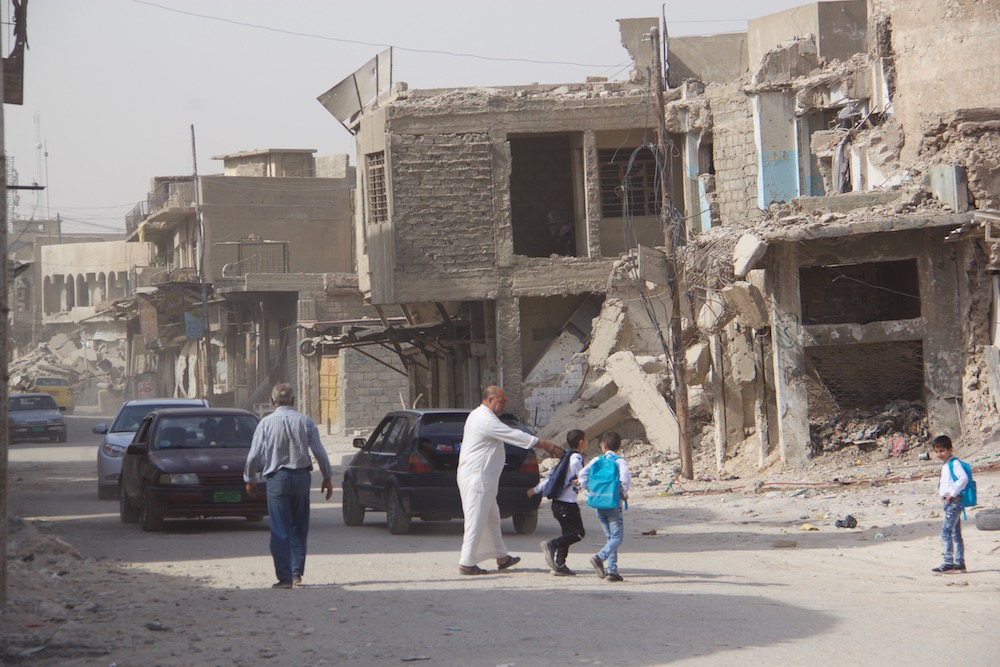
Mr. Ghazi was born and raised in Mosul, one of Iraq’s biggest cities, with a pre-ISIS population of about 1.5 million. What has befallen his city is an utter disaster, he says, but he remains hopeful that West Mosul can be rebuilt. “When the people gather together and put their hands to work in Mosul,” he says, smiling broadly, “there is nothing impossible here.”
His optimism is refreshing, but it is hard to imagine on this dusty morning how this city can be restored. Across the Tigris, Mosul’s eastern half has largely been spared the devastation visited on this side of the river, and life proceeds there much as before, with one glaring difference: Virtually all the Christians, once a small but significant part of the cultural fabric of Mosul, are gone. This is part of a larger exodus that has seen the Christian population of Iraq—ethnic Assyrians, Chaldeans and other minorities who belong to the Syriac Orthodox, Syriac Catholic, Chaldean Catholic and other churches—fall from more than 1.4 million at the beginning of the century to a few hundred thousand today.
Virtually all the Christians, once a small but significant part of the cultural fabric of Mosul, are gone.
While many Christians return during daylight to check on the condition of their former homes, only a handful so far have returned to live in Mosul. They have been warmly welcomed back by their Muslim neighbors, Mr. Towaya is quick to point out. He clings to his own small hope for the restoration of Mosul’s Chaldean, Syriac and other Christian communities. He believes that if the church comes back, the people will follow.
“They want to return to their houses,” he says. “They are afraid. Until now they have no confidence to return to Mosul…. But if one of the priests or bishops will return, I think the people will earn courage and they will return to Mosul quickly.”
But many of Mosul’s former Christian residents insist they will never return. Members of scores of Christian families who now live scattered across the Ankawa District in Erbil can tell the same story as Maryam, 22, and her sister Wasan, 18. As the sounds of gunfire and explosions announced the approach of Daesh militants in the early morning hours of June 10, 2014, they fled with just the clothes on their backs—a few minutes ahead of Daesh but in the wake of escaping police and Iraqi security forces. Maryam remembers watching the soldiers strip off their uniforms as they escaped ahead of the terrified Christians.
Like hundreds of other Christian families from Mosul and Nineveh, the two sisters have made lives for themselves in near exile in Iraqi-Kurdistan, a few hours away by car. They now attend the Catholic University of Erbil and hope to find professional work when they graduate. Their father, Yousif, has little enthusiasm for life in Erbil, a city of nearly a million, but he insists that he and his children will never go back to Mosul.
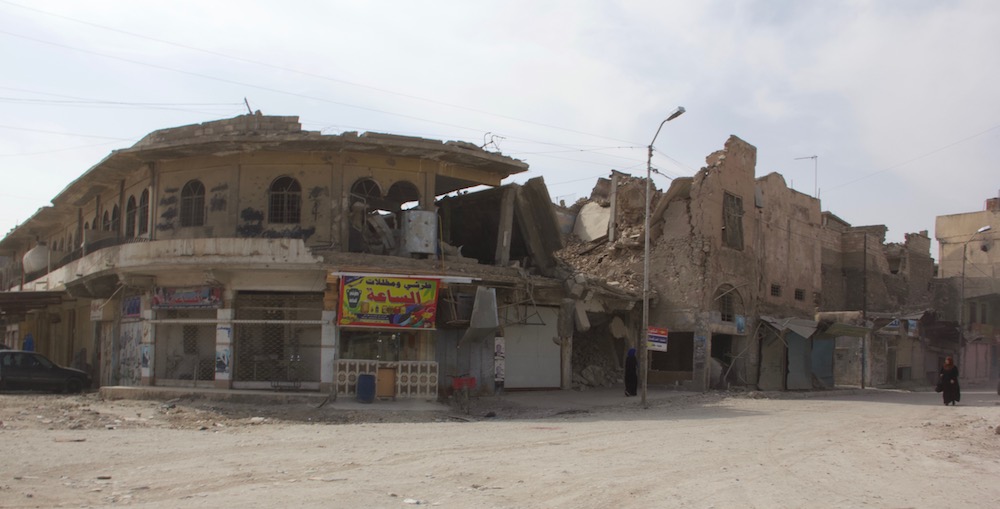
“How can we live with them again?” Maryam asks of former neighbors who welcomed ISIS even as Christian families fled. “My father lived his whole life with them, talking with them, working with them, and just like that, that is how they treat us?
“No, I don’t think so,” she says, her bright smile dissolving. “I don’t think that trust can ever be restored.”
Yousif is ready to leave Iraq behind forever if another nation (the United States, he suggests) accepts him and his family, but he has experienced nothing but frustration in various attempts to get his family officially settled elsewhere as refugees. How can the international community stand by and do nothing to help us, he wonders. He does not understand the world’s silence before the massive groan of Christian suffering in Iraq.
Who Can Forgive?
The Chaldean Catholic archbishop, Bashar Warda, leader of the Diocese of Erbil, has also puzzled over the global silence about the crisis of Christianity in Iraq. For years, since the ISIS offensive across the Province of Nineveh in northern Iraq made him the de facto pastor of hundreds of displaced Christian families, he has struggled to raise international attention to the plight of Christians and other religious and ethnic minorities here. His improvised relief effort was largely funded by the local church and international Christian humanitarian agencies like Aid to the Church in Need and the Knights of Columbus in the United States.
However small the remaining Chaldean, Orthodox and other Christian communities, Archbishop Warda insists that Christians still have an important role to play in Iraq. They must be the bridge builders, the mediators, the connectors among the nation’s many religious and ethnic divides, he says.
Christians here have one more important but difficult job to perform, he said. “ISIS is sin of the 21st century,” he says, “and this evilness should be challenged, stopped, terminated, but most important, forgiven.”
He says it is up to the people who have been most wronged by ISIS to forgive them. “Only the victims of this sin…are the ones who are qualified to forgive,” he says, and the archbishop believes that the region’s Christians bear a special obligation to do so.
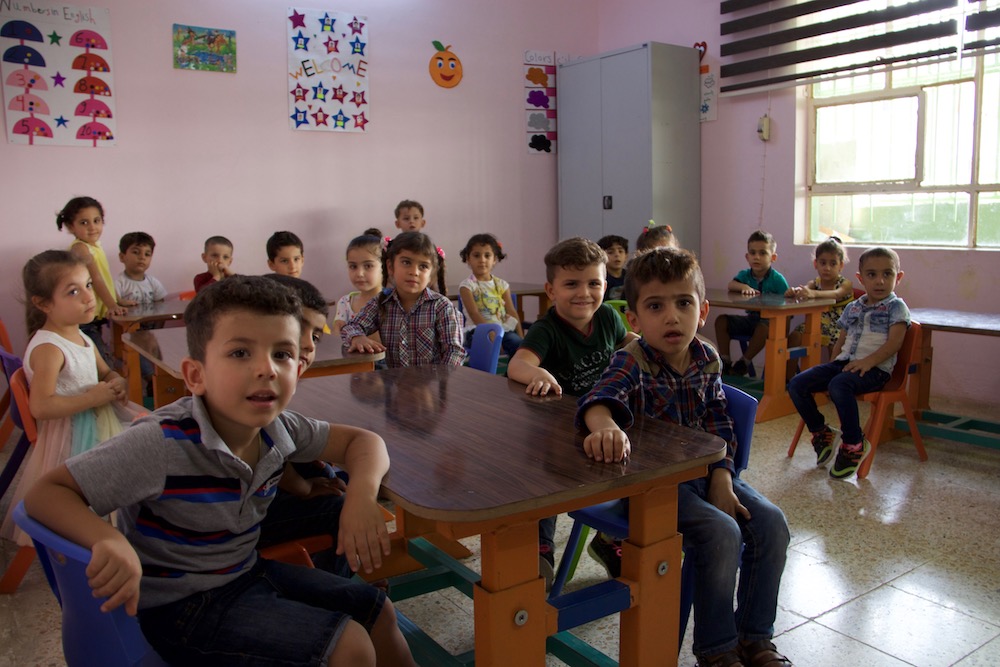
The archbishop was in Washington in December 2018 to witness the signing of legislation that would send more U.S. humanitarian aid directly to nongovernmental organizations and church-based committees struggling to rebuild Nineveh’s war-wracked communities, bypassing Iraq’s central government. Archbishop Warda believes that the plan to fund rebuilders directly should accelerate reconstruction here—virtually no one in Erbil believes Baghdad would spend aid money fruitfully—but he says so much more needs to be done, and done soon, to prevent the extinguishment of the Christian light in Iraq.
The Christian presence in Iraq, which can trace its lineage back to first-century communities believed to have been established by the apostles St. Thomas and St. Thaddeus, had already suffered significant decline even before the ISIS rampage across Nineveh. For decades, as U.S. no-fly zones and sanctions wore down the Iraqi economy, Christians who had the means left the country for jobs and opportunities elsewhere in the Middle East, Europe and the United States.
Archbishop Warda declines to speculate about the exact number of Christians left in Iraq today. The most optimistic estimates say that 300,000 remain. But harder assessments report that 150,000 Christians or even fewer hang on, a perhaps irreversible decline from the population that exceeded 1.5 million—about 6 percent of the country’s population—before the U.S. invasion in 2003. Those Christians who remain cite the many practical obstacles to leaving Iraq, but a harder-to-define spiritual and cultural obstinacy also seems to be playing a role.
Archbishop Warda: Christians must be the bridge builders, the mediators, the connectors among Iraq’s many religious and ethnic divides.
One evening in October two young Chaldeans describe the experience of living as members of a Christian minority in Iraq. One, Ramin, had fled with his family from the city of Kirkuk even before ISIS attacked because of a previous round of hostility and death threats from his Muslim neighbors. The other, Alin, says that for members of a minority faith, even an Iraqi city like Erbil, relatively at home with diversity, can be filled with petty indignities.
Yet these two men plan to stay in Erbil and try to build lives here. They recognize the barriers to legal asylum in Europe and the United States and say the illegal route into Europe has proved far too dangerous. The same week we talked, a funeral procession circled the Cathedral of St. Joseph in Erbil, bearing the bodies of two Chaldean youths who had drowned off the coast of Greece in a futile, fatal effort to escape to Europe.
The young men also say they simply do not want to start all over somewhere else.
“This is where my family is, this is where my friends are, this is where my church is,” says Alin. “We [Assyrian Christians] are the indigenous people of this land. We built this civilization, we built this country,” he says defiantly.
He intends to stay, but does he maintain much hope for the Christian community in Iraq? He shakes his head. Alin says he “cannot think of the future.” The challenges of each day are enough for him.
A Vocation of Presence
“We have moved from an established church to a missionary church,” Archbishop Warda says, as close to an acknowledgment as you are likely to hear from him about how severely Christian numbers have been diminished in the Nineveh region and Iraq. The Christians who remain to rebuild must accept life here as a vocation, he believes, “because there is no [other] reason for them to stay and there are hundreds of reasons for any family to leave the country—[lack of] security, lack of education, lack of a dignified life, lack of trust in the future…. All of these reasons are justified.”
“I cannot but say, ‘Yes, you are right, you have to care for your family and what [you have] already experienced is too much’,” he admits. “But despite all this, I have people who say, ‘No, this is our land, I have to stay, no matter what happens.’... I have to think, here we have a vocation.”
It is no easy vocation. Although ISIS has been driven from the territory it had claimed in central and northern Iraq, its ideology persists, and Sunni resentment toward Iraq’s Shiite leadership and Baghdad policymaking in the region remains unresolved. The political situation in northern Iraq has grown only more complex and unstable.
Sunni resentment toward Iraq’s Shiite leadership remains unresolved. The political situation in northern Iraq has grown only more complex and unstable.
After an ill-conceived independence referendum provoked a military incursion by Iraqi Security Forces in September 2017, the Kurdistan independence movement splintered into factionalism that threatens to break out into violence. Though Turkey and Iran maintain a shared hostility to the Kurdish Workers’ Party, which they regard as a terrorist organization, the two regional powers have been otherwise locked in a struggle for de facto control of Nineveh, the heartland of Iraq’s Assyrian Christians. The Iraqi central government at times seems barely a player in Nineveh’s drama.
The United States, after sacrificing thousands of lives and trillions of dollars on the destruction of the Saddam Hussein–led Baathist establishment in Iraq, appears to many Christians similarly ineffectual in Nineveh. They believe it is Iran that has emerged with the most coherent strategy to control the region.
“The Iranians will never protect the Christians,” my Erbil security expert says. “The Americans are sleeping; they don’t know what they are doing.”
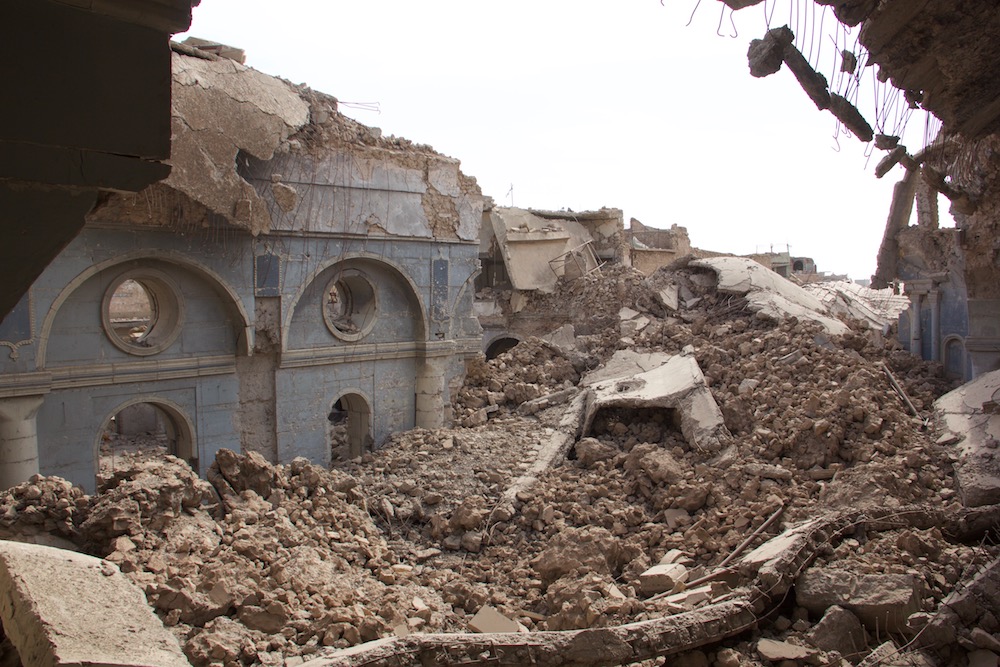
It is an observation repeated often. Christians marvel at American ineffectiveness and see Iranian intrigue behind any number of civic and political mutations in northern Iraq. Though Shiite militia helped dislodge the despised Daesh, many now wonder if the Christians in Nineveh are only a few years away from confronting a new existential crisis—maybe a different variant of Islamic extremism, this time emerging from within Iraq’s Shiite community.
Bartella, once a largely Christian city, is experiencing a transformation that has created much hesitation to return among former Christian residents. The Shabak, a mostly Shiite ethno-religious community that established itself in Nineveh centuries ago, are moving into Bartella from surrounding villages, buying up Christian homes or squatting in properties abandoned by Christian families. The Shabak community for decades endured oppression under Saddam Hussein, and they were brutally victimized themselves by ISIS, but many Christians have come to view them not as possible allies and co-restorers of Nineveh but as rivals for control of the province.
Freed from Saddam’s Sunni tyranny, the Shabak are flexing newly acquired civic and political muscle. Shiite flags, outlawed under Saddam, fly defiantly from their roofs. Shabak irregulars filled the ranks of the Hashd al-Shaabi militias (Popular Mobilization Units) that helped defeat Daesh, and now they patrol Bartella’s streets as the only real law enforcement in town. Christian merchants say they are regularly harassed and intimidated by the militiamen, who extract “taxes” in the form of free goods from Christian liquor stores or name their own prices when paying for commercial services from Christians. Who can admonish them?
In other Nineveh communities, a Christian militia, the Nineveh Plains Protection Unit, offers some reassurance, but the N.P.U. is poorly equipped and thinly ranked; few believe it would constitute a reliable defense in the event of another ISIS-level onslaught. In fact, many Nineveh Christians say that however much they distrust U.S. strategic and geopolitical judgment, it is only U.S. boots on the ground that will provide their beleaguered community with protection it can count on.
Signs of Life
As disheartening as are the ruins of Mosul and the region’s complicated politics, a short drive north from Mosul through Iraqi army and Shiite militia checkpoints delivers visitors to Qaraqosh and perhaps some good news about Christian viability in Nineveh. Like Mosul, this Christian city suffered three years of ISIS occupation and was pounded by artillery fire and aerial strikes by the Iraqi military in the campaign to take it back from the militants. The city’s residents fled en masse in August 2014 after Kurdish pesh merga fighters, who had promised to protect Qaraqosh, evacuated just ahead of an ISIS offensive.
But in early October, 17 months after the first of Qaraqosh’s wary residents returned in shock to a city in ruins, storefronts in the city center are open for business, and families and young people are out enjoying the welcome cool of the early evening. They are shopping, heading to restaurants, arguing with friends or just enjoying a stroll, taking care to avoid the construction debris that has turned the city’s sidewalks into an obstacle course.
A kindergarten sponsored by Jesuit Refugee Service has opened to scores of children who will have no memory of their families’ desperate flight from the city almost five years ago; an adjoining low-income housing complex has been restored, and many of its residents have returned to reclaim apartments once occupied by ISIS militants—just a few of the signs of life in this long-suffering community.
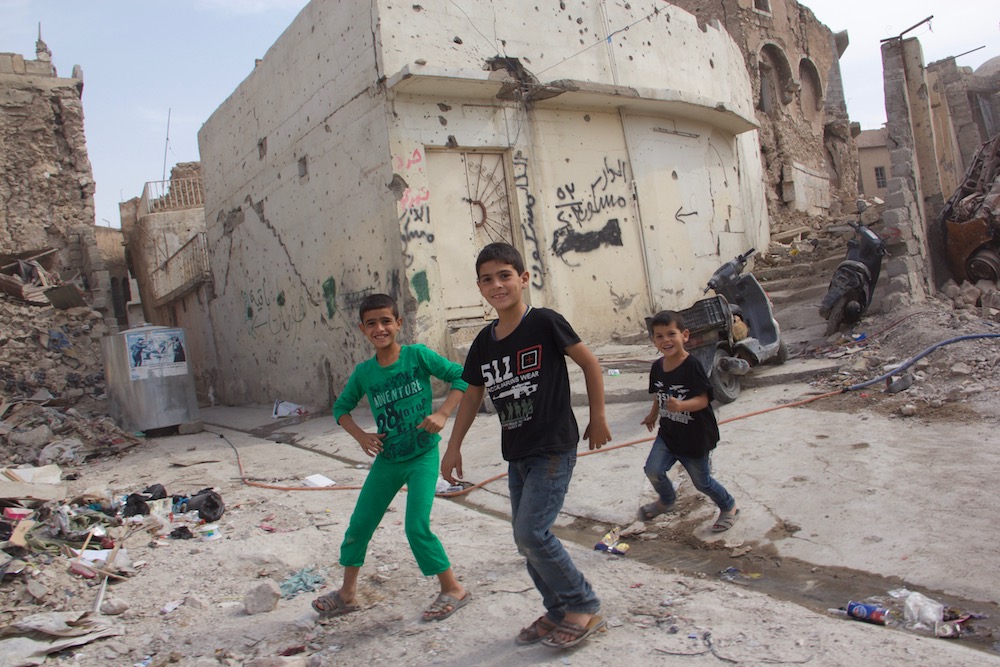
The Nineveh Reconstruction Committee, an ad hoc church-led restoration effort drawing support and expertise from a number of U.S. and European charities, has sponsored much of the rebuilding in Qaraqosh, one part of an ambitious effort to rebuild Nineveh’s Christian communities across Nineveh. The committee reports that about 40 percent of the 14,000 damaged homes it has selected for repair are now habitable and that 46 percent of the families who had fled ISIS have returned. The N.R.C. has helped restore hundreds of homes in Qaraqosh, but the Rev. George Jahola, a Syriac Catholic priest who is president of the Church Supreme Board for the Reconstruction of Baghdeda (the city’s Assyrian name), worries that progress will remain on track only if more funding can be secured.
On a conference room wall at the Syriac Catholic community center, Father Jahola points to a giant map of Qaraqosh. It shows in detail the specific damage at individual Christian homes: Virtually all were stripped bare by looting; many were also damaged by fire and explosives; and others were destroyed completely by ISIS or by Iraqi or U.S. mortar or air strikes. Another map highlights which houses have been restored, which are nearly finished and which will require complete reconstruction.
It is painstaking work, but Father Jahola seems pleased by the thoroughness and precision of his efforts. Each restored home on his map is a small mark of hope for the viability of the Christian community in Iraq.
Each restored home on Father Jahola’s map is a small mark of hope for the viability of the Christian community in Iraq.
Father Jahola’s remarkable progress in Qaraqosh has been repeated in other Christian communities across Nineveh. In the town of Karamles, about 60 percent of the homes have been restored, and work continues to repair the Shrine of St. Barbara. It had been desecrated and transformed into a sniper’s nest by ISIS. In Teleskuf, where Christians have been displaced twice—first by ISIS and then by fighting between Peshmerga and Iraqi government forces—most of the damaged homes have been repaired and the church of St. George beautifully restored.
Millions have been raised by the N.R.C. and other Christian aid groups and millions spent so far on this complex, ongoing effort, but how many Iraqi Christians will return from exile to inhabit these resurrected communities remains a poignant question.
However much assistance Father Jahola is able to cobble together for individual families, many who have left Nineveh say they will never be persuaded to return. Rashel Nadir, 20, a student at the Catholic University of Erbil, says she and many of her generation would surely stay in Iraq if security and minority rights could be more certain. But the chaotic status quo is not acceptable. “We cannot be a victim again of ISIS or another group,” she says, recalling what a near thing her family’s escape from Qaraqosh had been. “We cannot do that.”
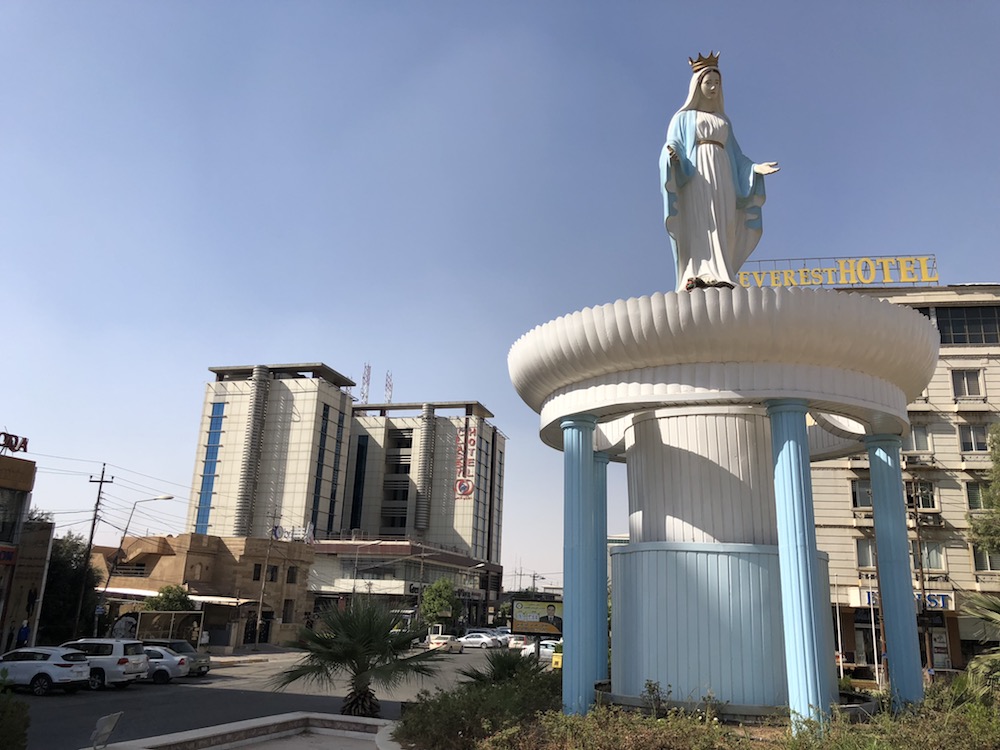
Joe Cassar, S.J., leads the efforts of Jesuit Refugee Service in northern Iraq with programs on either side of Iraqi government and Kurdish Peshmerga lines of control. In Jesuit fashion, he and his team have focused on creating educational opportunities for young people in neighborhoods being restored in Qaraqosh, in addition to assisting internally displaced people—Yazidi families driven out of Sinjar by ISIS—in the Sharya camps near the Kurdish city of Dohuk.
One J.R.S. enrichment program serves a dual purpose. Assisting young people whose educational path has been severely derailed by years of war, it also seeks to reconnect former neighbors in a district shared by Christian and Shabak families, the same Shiite community that is raising anxiety levels among Christians in Bartella. “Yes, it is important and necessary to rebuild houses,” Father Cassar explains. “But it is important also to rebuild trust.”
Archbishop Warda has launched a number of development campaigns in Erbil that he insists will mean that Christians will not merely survive in Iraq, but thrive here. In January the diocese opened a new, modern hospital. Across Nineveh, Catholic and Assyrian-language schools have been restored.
Administrators at the new Catholic University of Erbil hope to enroll hundreds of Christian students in the coming years. The diocese has also sponsored new apartments for young married couples and built a shopping complex; it continues to seek opportunities to create jobs for Erbil’s well-educated and restless youth—all part of a tireless effort to rebuild the Christian community and hope in Iraq.
“If there is no Christian presence, then this area of the world would not be lighted by the presence of the Gospel and the good news. That’s the basic thing,” Archbishop Warda says. He is unable to countenance “leaving an area without the presence of Jesus.”
“And when we come to an area affected by sin, well, that’s where Christians also are needed,” he says, “and when we are being crucified and persecuted, also we are needed.”
“A Middle East without Christians, well,” he grimaces, “no one could imagine this.”
Portions of this article were first published online in a series of reports by Kevin Clarke in October 2018.
Find out how you can help:
Aid to the Church in Need
Catholic Near East Welfare Association
Catholic Relief Services/Caritas Iraq
Chaldean Archdiocese of Erbil
Jesuit Refugee Service Middle East and North Africa
Knights of Columbus Christian Refugee Relief
Nineveh Reconstruction Committee

